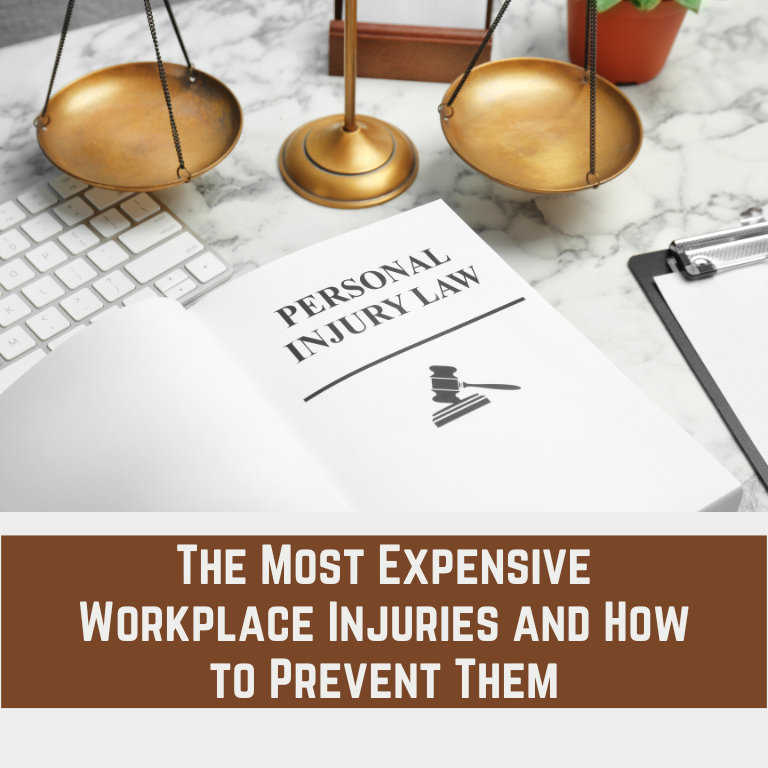The Most Expensive Workplace Injuries and How to Prevent Them

Workplace safety is a paramount concern for businesses across industries, not only for the well-being of their employees but also for minimizing costly claims. A new survey from Travelers, based on an analysis of 1.2 million workers’ compensation claims from 2017 to 2021, sheds light on the most frequent and severe causes of workplace injuries. The findings offer critical insights into where risks exist and how companies can tailor their risk management strategies to prevent accidents and reduce the financial impact of workers’ compensation claims.
Most Frequent Causes of Workplace Injuries
According to the survey, five main types of accidents account for the majority of workplace injuries, which often lead to workers’ compensation claims. These accidents are costly, not only in terms of claims but also in lost productivity and human suffering. Understanding these key causes is essential for employers looking to enhance safety protocols and protect their workforce.
Overexertion (29%)
Overexertion is the leading cause of workplace injuries, accounting for 29% of all claims. This category includes injuries caused by excessive physical effort, such as lifting, pushing, pulling, carrying, or throwing heavy objects. Overexertion injuries often result in musculoskeletal disorders, particularly in the back, shoulders, and neck. These injuries are common in labor-intensive industries such as construction, manufacturing, and warehousing.
Slips, Trips, and Falls (23%)
The second most common cause of workplace injuries is slips, trips, and falls, which represent 23% of claims. These accidents can occur in any work environment, from office settings to construction sites. Slips and trips are often the result of wet floors, uneven surfaces, poor lighting, or obstructions in walkways. Falls can also happen from heights, such as ladders, scaffolding, or rooftops. These injuries can range from minor bruises to severe fractures and head trauma.
Being Struck by an Object (12%)
Being struck by an object accounts for 12% of workplace injuries. This can include being hit by falling tools, equipment, or materials, as well as injuries caused by moving objects like vehicles or machinery. Workers in construction and manufacturing industries are particularly vulnerable to these types of accidents, which can lead to severe injuries, such as fractures or concussions.
Motor Vehicle Accidents (5%)
Motor vehicle accidents make up 5% of workplace injuries. Employees who drive as part of their job, such as truck drivers, delivery personnel, and those in transportation services, face an increased risk of accidents. These accidents can result in serious injuries or fatalities, leading to costly workers’ compensation claims and significant lost workdays.
Caught-In or Caught-Between Hazards (5%)
Caught-in or caught-between hazards are responsible for another 5% of workplace injuries. These occur when workers are caught, crushed, or pinched between two objects or parts of machinery. Such accidents often happen in construction and manufacturing settings, where heavy machinery is commonly used. These injuries can be life-threatening and lead to severe physical trauma.
The Impact of Severe Claims
When focusing on severe claims, those costing $250,000 or more, the top drivers remain consistent with the overall data:
- Slips, trips, and falls
- Overexertion
- Being struck by an object
- Motor vehicle accidents
- Caught-in or caught-between hazards
These types of accidents not only lead to significant financial costs but often result in long-term or permanent injuries, which can dramatically affect an employee’s ability to work. Severe injuries also contribute to higher workers’ compensation costs and a more challenging path to recovery for employees.
New Employees at Higher Risk
The survey highlighted an important and concerning trend: 35% of workplace injuries occur during an employee’s first year on the job. In 2023 alone, this translated to six million missed workdays due to injuries. New employees are often at greater risk because they may be less familiar with safety protocols, less experienced in handling job-specific hazards, or still adapting to the physical demands of their roles.
Employers need to recognize this heightened risk and invest in comprehensive training programs, onboarding safety protocols, and mentoring systems to protect new hires from preventable injuries.
Lost Workdays by Industry
The number of days employees miss due to injury varies significantly across industries. The survey revealed the following average lost workdays by sector:
Construction: 103 days
Transportation: 83 days
Services: 72 days
Wholesale: 71 days
Manufacturing: 67 days
These statistics underscore the significant impact that workplace injuries can have on business operations, particularly in industries like construction, where lost workdays can severely disrupt project timelines and increase operational costs.
Common Injury Types Leading to Lost Workdays
Certain injuries are more likely to result in lost workdays. The data from the survey identified the most common injuries leading to time off from work:
Dislocations: 142 days
Fractures: 92 days
Inflammation (e.g., tendonitis): 85 days
Strains and sprains: 54 days
Contusions (bruising): 30 days
These injuries, while varying in severity, all contribute to a significant loss of productivity and add to the overall cost of workers’ compensation claims. Strains and sprains, for example, are common in overexertion injuries, while dislocations and fractures often occur from slips, trips, falls, and being struck by objects.
Industry-Specific Trends
Certain industries exhibit specific injury trends. For example:
In the wholesale sector, lower back injuries are the most common, often resulting from overexertion or improper lifting techniques.
In manufacturing, shoulder injuries are frequent, likely due to repetitive motions or working with heavy materials.
For small businesses, slips, trips, and falls are the most prevalent cause of injury, highlighting the need for robust safety protocols even in smaller work environments.
The High Cost of Construction Claims
Construction industry claims stand out as particularly costly. According to the survey, construction workers’ compensation claims are nearly double the average cost across all industries. This is likely due to the high-risk nature of the work, which involves heavy machinery, heights, and physically demanding tasks. Severe injuries in construction, such as falls from scaffolding or being caught in machinery, often result in long-term recovery times and substantial medical expenses.
Preventing Workplace Injuries
Rich Ives, Senior Vice President of Business Insurance Claims at Travelers, emphasized the need for proactive measures: “Factors such as inexperience, workforce shortages, and maintenance issues are all contributing to these unfortunate and often avoidable accidents.”
While the overall number of workplace injuries has been trending downward in recent years, Ives’ statement underscores the importance of continued investment in workplace safety and injury prevention. Employers must prioritize:
Comprehensive safety training programs, especially for new hires.
Regular equipment maintenance to prevent mechanical failures or accidents.
Implementing ergonomic solutions to reduce overexertion injuries.
Improving workplace design to minimize slips, trips, and falls.
The findings from Travelers’ survey offer a clear picture of the most common and costly workplace accidents. Overexertion, slips, trips, and falls, being struck by objects, and motor vehicle accidents remain the top drivers of workers’ compensation claims. While many of these accidents are preventable, they continue to pose a significant risk, particularly to new employees and those in high-risk industries like construction and transportation.
By understanding where risks lie and implementing tailored safety strategies, businesses can help prevent injuries, protect their employees, and reduce the financial burden of costly claims. In an environment where workplace safety is not only a legal obligation but also a vital component of business success, investing in prevention is more important than ever.











